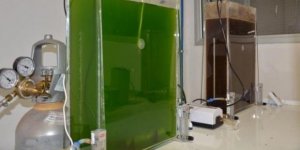| News / Science News |
Scientists discover genetic basis for how harmful algae blooms become toxic
In a new study, researchers identified a cluster of genes related to the production of domoic acid in microscopic plants, or phytoplankton, called Pseudo-nitzschia.

Dense cells of the harmful algae Pseudo-nitzchia during a bloom off the West Coast of North America. ![]()
The researchers found that the genes contain the biological directions for how the toxin is made; these genes are "switched on" when Pseudo-nitzschia is producing domoic acid.
By showing how genes for domoic acid production are turned on, the authors suggest a way to connect the ocean conditions that drive algae blooms with the development of toxin production.
Harmful algae blooms often come in the form of "red tides," so called because of the reddish tint they lend ocean waters. The blooms occur when phytoplankton grow rapidly, sometimes producing toxins that can sicken marine mammals and other species.
Harmful algae blooms also pose a threat to human health when the toxins accumulate in seafood. A high-dose exposure to domoic acid can lead to amnesic shellfish poisoning, a potentially fatal condition marked by seizures and short-term memory loss.
Several states have been severely impacted by harmful algae blooms. The largest harmful algae bloom ever recorded happened in the summer of 2015 off the West Coast of North America from Alaska to California, and resulted in the closure of fisheries to protect consumers from potential shellfish poisoning.
Harmful algae blooms are difficult to forecast, scientists have found. The bloom-causing organisms usually have very complex genomes. Knowledge of the genes involved in domoic acid production will allow for better monitoring of algae blooms, scientists say, and aid in identifying the conditions that trigger toxin production.
When phosphate in the ocean is limited and the amount of carbon dioxide increases, Pseudo-nitzschia can make large amounts of domoic acid and become harmful.
Carbon dioxide in the sea is increasing above natural levels. Along with rising ocean temperatures, these conditions lead to more prevalent, more toxic, and longer-lasting blooms and domoic acid production.
Researchers who work on monitoring and forecasting harmful algae blooms say the findings offer an increased understanding of the phenomenon, and will help predict domoic acid events in response to climate change. (National Science Foundation)
YOU MAY ALSO LIKE



